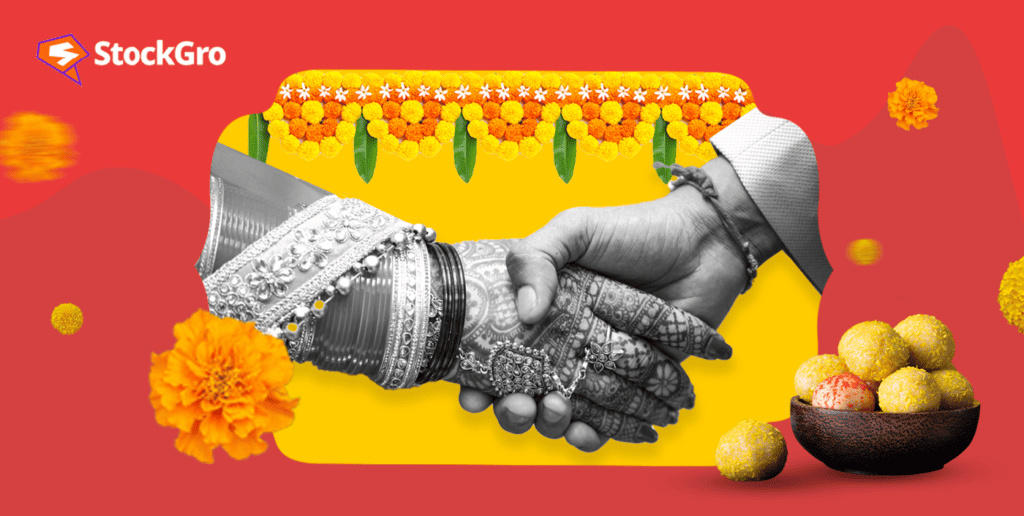
Let’s begin with an interesting fact: Wedding and marriage are not synonymous. Did you know that?
While wedding is a term that describes the physical ceremony, marriage is the companionship of two people that starts after the wedding.
So, which of the two is more important, according to you? A grand wedding or a successful marriage? That is a debatable topic for another day.
In today’s article, let us discuss the changing perspectives on weddings and how they impact the Indian economy.
The wedding season in India
Indian weddings happen throughout the year. While South Indian weddings are spread evenly across the year, most North Indian weddings are planned during the last quarter of the year.
November and December are festival seasons in India. It is that time of the year when holidays and celebrations take priority. So, some people choose to celebrate their wedding along with the existing celebrations.
So, November and December every year is termed as the first phase of the “Wedding Season” in India.
What has changed in Indian weddings?
Indian weddings are no longer simple and traditional. While some age-old rituals are still in practice, the basic idea of a wedding has changed from a mere tradition that commences the marriage of two people to a grand affair that celebrates two people and their union.
Though there is a portion of people who still prefer simple, intimate court weddings, a large section of the population prefers celebrating it with all grandeur.
Expensive venues, a variety of feasts for each event, a week-long celebration and personalisation to top them all have become the go-to plans of big fat Indian weddings. And, not to forget, the designer clothes for the bride and groom, and customised luxury gifts for all the guests.
Surely, heavy on the pockets, what do you think?
Also read: Everything you need to know about Diwali Muhurat Trading 2023
How do Indian weddings impact the economy?
According to a survey conducted by the Confederation of All India Traders (CAIT), India will witness close to 35 lakh weddings in a period spanning 23 days, from Nov 23 2023, to Dec 15 2023, leading to a money flow of ₹4.25 lakh crores in the economy.
Weddings have a ripple effect on the economy. They increase consumer spending and lead to a rise in the overall economic activities of the country. During the same time, last year, 32 lakh weddings happened in the country. The wedding season is expected to be bigger this year, with an average cost of ₹12 lakhs per wedding.
The approximate budget for the 35 lakh weddings between 23rd Nov to 15th Dec 2023, is as below:
- 6 lakh weddings – ₹ 3 lakh per wedding
- 10 lakh weddings – ₹ 6 lakh per wedding
- 12 lakh weddings – ₹ 10 lakh per wedding
- 6 lakh weddings – ₹ 25 lakh per wedding
- 50,000 weddings – ₹ 50 lakh per wedding
- 50,000 weddings – ₹ 1 crore per wedding
The influence of COVID-19 on our lives has slowly reduced, and the country is almost getting back in shape. 2023 is the first wedding season post-COVID that will witness festivities without the fear of the virus. So, this wedding season is special for most families who have been anticipating the celebrations.
Impact of the wedding business on different industries
The tourism industry
– It is not just the number of weddings that is rising in India, but also the fascination for destination weddings. More and more people are inclined towards destination weddings today, which is undoubtedly a boon to the country’s economy. India is a country rich in culture and diversity.
States like Rajasthan, Goa, and Kerala are some of the most sought-after destinations. The government of India is also actively involved in promoting India as one of the most preferred wedding destinations, thereby boosting tourism in the country.
The hospitality industry
– Weddings are considered the key contributors to revenue in hotels and restaurants during the peak wedding season. The luxury and customised decor and food menu are one of the prime ways for these venues to make profits from weddings.
The rise of social media has also contributed to the growth of the hospitality industry, with more collaborations with influencers and celebrities, which has led to an increase in business during weddings.
The jewellery industry
– Jewellery, especially gold jewellery, is an integral part of Indian weddings. While some people see it as a tradition to gift gold to the bride and groom, others see it as a symbol of status and respect.
According to the World Gold Council, 55% of the market share for gold is held by bridal gold jewellery. As per a survey in 2019, 17% of the gold jewellery purchased in the country’s retail market was for weddings. With more weddings this year, the demand for gold jewellery is only expected to rise.
Also read: Tata technologies IPO after 20 years in the TATA conglomerate.
The job market
– The wedding industry has a positive impact on employment, as well. The majority of the households plan to paint and renovate their houses during weddings, which increases the demand for construction workers in the country.
Event management is also a booming career in India today. Weddings are one of the prime specialities of event management companies.
Wedding tax
The taxation policy on wedding gifts is a sigh of relief for Indian citizens.
Wedding gifts, either in cash or in any kind, are not taxable according to Section 56 (2) of the Income Tax Act of 1961. However, they are tax-free only if the below conditions are met:
- The gifts must be received during the wedding only and not any other events related to the wedding, like engagement, reception, etc.
- The gifts must be received by the bride or the groom and not any other relative. Gifts received by others are taxable if the value exceeds ₹50,000.
You may also like: Sugar export ban – Too sweet to digest?
Bottomline
Indian weddings are a reason for celebration not just for the families but for the entire economy.
True to the terms used to describe Indian weddings – “Big” and “Fat”, their impact on the economy is also huge. The changing outlook of people towards weddings has led to positive impacts on various sectors of the economy.
The wedding season this year is fast approaching, and it is expected to be bigger than ever. Is your wedding one among the 35 lakh weddings?

